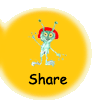
|
Gives Humans a Sixth Sense
Suppose you weren't the only one who couldn't hear. Imagine that no other person, nor any creature, had a sense of hearing. All anyone would know about the world would come from what they could see, smell, feel, or taste. We wouldn't know that birds chirp and sing, that the wind whistles in the trees, or that lightning is followed by thunder. We would probably talk using sign language. What other differences can you imagine in such a world? In some ways, we do live in such a world. For the Universe is filled with "sounds" that we've never been able to hear. So far, almost everything we know about the Universe we have learned by observing light, in all its forms. We have many different kinds of telescopes--on the ground and in space--for observing the different wavelengths of the electromagnetic spectrum. But there is much more we learn about the universe if only we could detect  What are gravitational waves? We know what gravity is--or at least we know what it does. Without gravity, Earth would stop orbiting the Sun and travel on its own into the Milky Way Galaxy. The Milky Way itself would come apart, because the stars would not hold the galaxy together. In exactly the same way, the moon would stop orbiting Earth and move away in a straight line. And everything that is not held down to the ground here on Earth would just float off into space. But even though gravity is a common a part of our everyday lives, it is the most mysterious force in the universe. We still don't understand it very well. |
|
Albert Einstein was a great scientist who discovered quite a number of things about the way the Universe works. Most of his ideas have been proven correct by experiments and observations. One of his ideas is that objects cause the space around them to curve. He thought that large objects, like the Sun, curve the space around them more than small objects do. Objects moving through space follow the curvature. When space is curved sharply enough--like it is around the Sun--planets, asteroids, and comets moving along the curve are in orbit! If not for the curvature of space, they would all travel straight into space, away from the Sun. And this is what gravity is really about. If mass curves space, then very large masses moving quickly through space would create ripples in space. Thus Einstein predicted gravitational waves--like ripples on a cosmic pond. |
|
|
|
Gravitational waves spread out from a binary star system (two stars orbiting each other). |
|
However, gravitational waves from even these cosmic happenings are very weak by the time they reach us from some far away star system, just as a loud sound that is far away can be very faint. Gravitational waves are very hard to detect, so we have never before been able to measure them. But if we could, they could tell us all sorts of things about the universe that we could not otherwise know. It would be like getting a whole new sense. It would be like hearing the universe for the first time, when up until now we have only been able to see it.
LISA will place three spacecraft in orbit around the Sun, tagging along behind Earth. The three spacecraft will be 5 million kilometers (3 million miles) apart flying in a triangle formation. When a gravitational wave passes by, these ripples in space gently push the spacecraft around by the tiniest amount imaginable. But the super-super-super sensitive laser beams that connect the three spacecraft (like a spider web made of beams of light) will allow this tiny movement to be measured. |
|
|
LISA will look for gravitational waves from stars and black holes. For example, the gravitational waves from two black holes orbiting each other could tell us how big (massive) the black holes are and how fast they are orbiting each other! |
|
|
LISA will help us understand much more about space and how our universe got to be the way it is--and perhaps even how it will change in the future. |
|
|
|||||
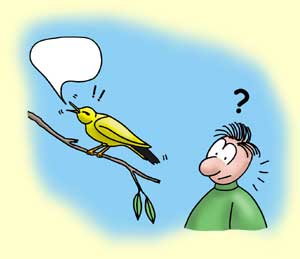 If
you are a person with normal hearing, can you imagine what
the world would be like if there were no sounds?
If
you are a person with normal hearing, can you imagine what
the world would be like if there were no sounds?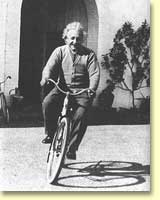
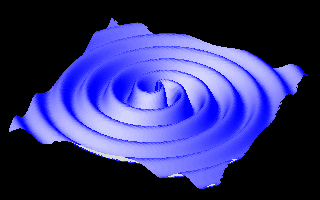
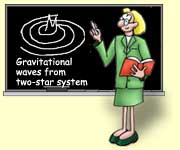 The
biggest gravitational waves would be caused by huge
events--for example, two huge stars orbiting each other, or
a massive star orbiting a black hole, or two black holes
orbiting each other.
The
biggest gravitational waves would be caused by huge
events--for example, two huge stars orbiting each other, or
a massive star orbiting a black hole, or two black holes
orbiting each other.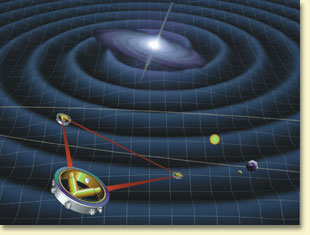 The
Laser Interferometer (in-ter-fear-AH-
The
Laser Interferometer (in-ter-fear-AH-





